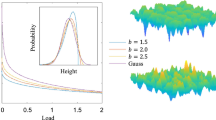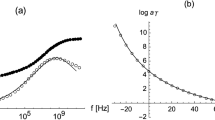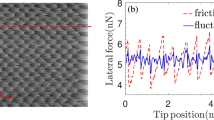Abstract
The role of surface roughness in contact mechanics is relevant to processes ranging from adhesion to friction, wear and lubrication1,2. It also promises to have a deep impact on applied science, including coatings technology and design of microelectromechanical systems3. Despite the considerable results achieved by indentation experiments4, particularly in the measurement of bulk hardness on nanometre scales5,6,7, the contact behaviour of realistic surfaces, showing random multiscale roughness, remains largely unknown. Here we report experimental results concerning the mechanical response of self-affine thin films indented by a micrometric flat probe. The specimens, made of cluster-assembled carbon8,9,10,11 or of sexithienyl12,13, an organic molecular material, were chosen as prototype systems for the broad class of self-affine fractal interfaces, today including surfaces grown under non-equilibrium conditions14, fractures15, manufactured metal surfaces16,17,18,19 and solidified liquid fronts20. We observe that a regime exists in which roughness drives the contact mechanics: in this range surface stiffness varies by a few orders of magnitude on small but significant changes of fractal parameters. As a consequence, we demonstrate that soft solid interfaces can be appreciably strengthened by reducing both fractal dimension and surface roughness. This indicates a general route for tailoring the mechanical properties of solid bodies.
This is a preview of subscription content, access via your institution
Access options
Subscribe to this journal
Receive 12 print issues and online access
$259.00 per year
only $21.58 per issue
Buy this article
- Purchase on Springer Link
- Instant access to full article PDF
Prices may be subject to local taxes which are calculated during checkout




Similar content being viewed by others
References
Bowden, F.P. & Tabor, D. Friction and Lubrication of Solids (Oxford Univ. Press, London, 1954).
Assender, H., Bliznyuk, V. & Porfyrakis, K. How surface topography relates to materials' properties. Science 297, 973–976 (2002).
Bishop, D., Gammel, P. & Giles, C.R. The little machines that are making it big. Phys. Today 54, 38–44 (2001).
Tabor, D. The Hardness of Metals (Clarendon, Oxford, 1951).
Pethica, J.B. & Oliver, W.C. Tip surface interactions in STM and AFM. Phys. Scripta T 19, 61–66 (1987).
Cappella, B. & Dietler, G. Force-distance curves by atomic force microscopy. Surf. Sci. Rep. 34, 1–4 (1999).
Li, J., Van Vliet, K.J., Zhu, T., Yip, S. & Suresh, S. Atomistic mechanisms governing elastic limit and incipient plasticity in crystals. Nature 418, 307–310 (2002).
Buzio, R. et al. Self-affine properties of cluster-assembled carbon thin films. Surf. Sci. 444, L1–L6 (2000).
Donadio, D., Colombo, L., Milani, P. & Benedek, G. Growth of nanostructured carbon films by cluster assembly. Phys. Rev. Lett. 83, 776–779 (1999).
Bogana, M., Donadio, D., Benedek, G. & Colombo, L. Simulation of atomic force microscopy of fractal nanostructured carbon films. Europhys. Lett. 54, 72–76 (2001).
Casari, C.S. et al. Acoustic phonon propagation and elastic properties of cluster-assembled carbon films investigated by Brillouin light scattering. Phys. Rev. B 64, 085417 (2001).
Biscarini, F., Samori, P., Greco, O. & Zamboni, R. Scaling behavior of anisotropic organic thin films grown in high vacuum. Phys. Rev. Lett. 78, 2389–2392 (1997).
Biscarini, F., Zamboni, R., Samorì, P., Ostoja, P. & Taliani, C. Growth of conjugated oligomer thin films studied by atomic-force microscopy. Phys. Rev. B 52, 14868–14877 (1995).
Barabasi, L. & Stanley, J. Fractal Concepts in Surface Growth (Cambridge Univ. Press, Cambridge, 1995).
Mandelbrot, B.B., Passoja, D.E. & Paulley, A.J. Fractal character of fracture surfaces of metals. Nature 308, 721–722 (1984).
Sayles, R.S. & Thomas, T.R. Surface topography as a nonstationary random process. Nature 271, 431–434 (1978).
Othmani, A. & Kaminsky, C. Three dimensional fractal analysis of sheet metal surfaces. Wear 214, 147–150 (1997).
He, L. & Zhu, J. The fractal character of processed metal surfaces. Wear 208, 17–24 (1997).
Shirong, G. & Gouan, C. Fractal prediction models of sliding wear during the running-in process. Wear 231, 249–255 (1999).
Pietronero, L. & Tosatti, E. (eds) Fractals in Physics (North Holland, Amsterdam, 1986).
Mandelbrot, B.B. Self-affine fractals and fractal dimension. Phys. Scripta 32, 257–260 (1985).
Keller, D. Reconstruction of STM and AFM images distorted by finite-size tips. Surf. Sci. 253, 353–364 (1991).
Warren, T.L. & Krajcinovic, D. Random Cantor set models for the elastic–perfectly plastic contact of rough surfaces. Wear 196, 1–15 (1996).
Yan, W. & Komvopoulos, K. Contact analysis of elastic–plastic fractal surfaces. J. Appl. Phys. 84, 3617–3624 (1997).
Persson, B.N.J. Elastoplastic contact between randomly rough surfaces. Phys. Rev. Lett. 87, 116101 (2001).
Weisenhorn, A.L., Khorsandi, M., Kasas, S., Gotzos, V. & Butt, H.-J. Deformation and height anomaly of soft surfaces studied with an AFM. Nanotechnology 4, 106–113 (1993).
Stifter, T., Marti, O. & Bhushan, B. Theoretical investigation of the distance dependence of capillary and van der Waals forces in scanning force microscopy. Phys. Rev. B 62, 13667–13673 (2000).
Persson, B.N.J. & Tosatti, E. The effect of surface roughness on the adhesion of elastic solids. J. Chem. Phys. 115, 5597–5610 (2001).
Abbott, E.J. & Firestone, F.A. Specifying surface quantity—A method based on accurate measurements and comparison. Mech. Eng. (Am. Soc. Mech. Eng.) 55, 569–572 (1933).
Putman, C.A.J., Igarashi, I. & Kaneko, R. Single-asperity friction in friction force microscopy: the composite-tip model. Appl. Phys. Lett. 66, 3221–3223 (1995).
Acknowledgements
We thank E. Meyer and B.N.J. Persson for discussions and P. Milani for providing ns-C samples. We acknowledge support by INFM advanced project NANORUB and ASI grant CTRI/R/073/01.
Author information
Authors and Affiliations
Corresponding author
Ethics declarations
Competing interests
The authors declare no competing financial interests.
Rights and permissions
About this article
Cite this article
Buzio, R., Boragno, C., Biscarini, F. et al. The contact mechanics of fractal surfaces. Nature Mater 2, 233–236 (2003). https://doi.org/10.1038/nmat855
Received:
Accepted:
Published:
Issue Date:
DOI: https://doi.org/10.1038/nmat855
This article is cited by
-
A General Load–Displacement Relationship Between Random Rough Surfaces in Elastic, Non-adhesive Contact, with Application in Metal Additive Manufacturing
Tribology Letters (2022)
-
Nano-vault architecture mitigates stress in silicon-based anodes for lithium-ion batteries
Communications Materials (2021)
-
Artificial intelligence-based predictive model of nanoscale friction using experimental data
Friction (2021)
-
Geotechnical properties of 3D-printed transparent granular soil
Acta Geotechnica (2021)
-
A novel tin ferrite/polymer composite use in photo-Fenton reactions
International Journal of Environmental Science and Technology (2021)



